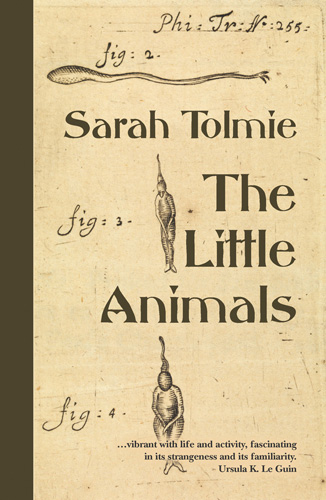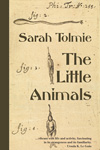

The Little Animals is available in trade paperback and ebook from
Just how different are the worlds of science and magical thinking? In the seventeenth century, the advent of natural philosophy, they were closely intertwined. Perhaps they were even the same.
Antoni van Leeuwenhoek, a quiet linen draper in Delft, has discovered a new world: the world of the little animals, or animalcules, that he sees through his simple microscopes. These tiny creatures are everywhere, even inside us. But who will believe him? Not his wife, not his neighbours, not his fellow merchants—only his friend Reinier De Graaf, a medical doctor. Then he meets an itinerant goose girl at the market who lives surrounded by tiny, invisible voices. Are these the animalcules also? Leeuwenhoek and the girl form a curious alliance, and gradually the lives of the little animals infiltrate everything around them: Leeuwenhoek’s cloth business, the art of his friend Johannes Vermeer, the nascent sex trade, and people’s religious certainties. But Leeuwenhoek also needs to cement his reputation as a natural philosopher, and for that he needs the Royal Society of London—a daunting challenge, indeed, for a Dutch draper who can’t communicate in Latin.
From the Cover
Ursula K. Le Guin
A vigorous, satisfying historical novel full of interesting and likable characters. To people who do truly unusual things, such as discover microscopic life, or paint Vermeer’s pictures, or hear what plague bacilli are saying, these things are just what they do. Sarah Tolmie’s novel catches this intersection of the everyday with the unearthly and holds it for us like a drop of pond water under the lens, vibrant with life and activity, fascinating in its strangeness and its familiarity.
Awards and Recommendations
Special Citation at the 2020 Philip K. Dick Award ceremony. The virtual ceremony can be watched online; a five-minute reading from The Little Animals is featured at 38:30.
Reviews
James Davis Nicholl, Tor.com (August 2019)
More ambitious than her previous prose efforts, The Little Animals is an entrancing gentle tale about science and natural philosophy, and the community around the Delft draper/scientist.
Gary K. Wolfe, Locus, Issue 700 (May 2019)
[A] charming mannerist fairy tale and a provocative account of the birth of our own modern worldview. […]
The Little Animals is, for the most part, a straightforward account of the early career of the 17th-century Delft scientist Antoni van Leeuwenhoek, as he discovers and records various ‘‘animalcules’’ through his homemade single-lens microscopes and tries to get his findings recognized by Britain’s Royal Society, at the time Europe’s chief arbiter of what was and wasn’t science. As Tolmie notes in an afterword, she took some liberties in moving Leeuwenhoek’s major discoveries earlier in his career, when his first wife was still alive, and in positing a largely conjectural friendship with his contemporary Vermeer, but her main concession to the fantastic is a mysterious goose girl, who seems to have walked straight out of the Grimm fairytale to take up residence, along with her preternaturally faithful flock of geese, in Leeuwenhoek’s household (initially, he just needed the quills from the geese for writing up his notes). The girl, who as in the original folktale carries with her a handkerchief with a few drops of her mother’s blood, claims to be able to hear the buzzing of the same animalcules that Leeuwenhoek observes, and later turns out to be able to see inside the minds not only of her geese, but of a horse (named Falada, as in the Grimm tale) and even the unborn child of Leeuwenhoek’s pregnant wife. While Tolmie builds sympathetic portraits of Leeuwenhoek, his wife, Vermeer, and several secondary characters (including a local English priest grappling with his own sexuality), it’s the unnamed goose girl who haunts the narrative, a marvel of liminality and nuance, at times reticent and affectless, at times a vulnerable and lonely girl with an astonishing sensory connection to the natural world. […]
What Tolmie does, often brilliantly, is develop a theme of patterns that reflect in various ways the underlying sense of order that seems to be emerging into the world she describes – not only the patterns of Leeuwenhoek’s observations, but the manner in which these become popular fabric designs (Delft was apparently known for fabrics before it was known for ceramics, and Leeuwenhoek himself made a living as a draper), and even in such details as his daughter’s dollhouse, the design of looms, and the sheet music that a local madam uses for her spinet.
Publishers Weekly, 1 April 2019 (starred review)
Tolmie (The Stone Boatmen) intricately weaves together the best of historical and weird fiction in this delicate tale of science and miracles. In 17th-century Delft, Holland, draper and scientist Antonie Leeuwenhoek is on the verge of a breakthrough discovery: that various substances are teeming with living “animalcules” that can only be seen by microscope. He is determined to prove his theories correct, though few people believe him. When he visits the Delft marketplace, he comes across a nameless, homeless goose-herding girl who says that she is followed by a cacophony of tiny voices. Leeuwenhoek strikes up an uneasy alliance with the girl, as he is certain the voices are those of the animalcules. Leeuwenhoek and the goose girl’s investigations into the worlds of the animalcules destabilize the realms of religion, art, and science. Tolmie balances careful characterization with rich historical detail, subtle humor, and energetic prose. Her central characters are suffused with color, and her prose captures the joys and uncertainties of life-changing discoveries. This delightful novel is not to be missed.